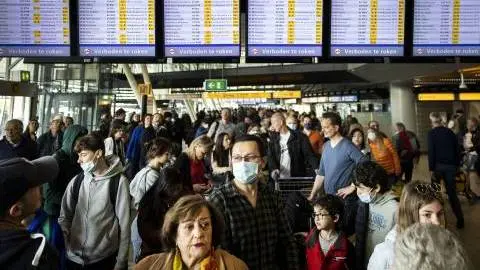Recession fears reach central and eastern Europe
With inflation rising swiftly, economic data suggests economic storm clouds will continue to gather over the summer in the CEE region. In the Czech Republic, the hiking cycle has likely peaked but in other countries, we believe it will continue despite fears of stagflation. Fiscal policy remains in an accommodative mode
Poland: Tricky navigation of anti-inflation policy amid stagflation risk
In the second quarter of 2022, Poland's GDP kept sound momentum of 7% year-on-year, only marginally weaker than the cyclical peak of 8.5% in the first quarter. Industry is growing at a double-digit pace, and market services even accelerated, with only the construction sector slowing. But the PMI collapse in June was the most severe in the region, with the index reaching a 25-month low. The main components, notably output and new orders, experienced a drop only seen during the pandemic and the global financial crisis. This supports our expectations for a technical recession in the second half of 2022, when GDP should slow to around 0.9% YoY in the fourth quarter. On the other hand, consumption doesn't show any signs of a slowdown despite very poor consumer confidence and spending plans. This may be explained by aggressive fiscal stimulus of more than 3% of GDP in 2022. Still, this year's growth should reach a sound 4.7% YoY. We are more worried about growth in 2023 which may reach 2.5% YoY.
CPI reached 15.6% YoY in June. While there are some signs that CPI is losing momentum, the index has set a new 25-year high and is far from its peak. We see CPI plateauing in the summer but then reaching a local peak in October and 1Q23 when a new wave of regulated prices and minimum wage hikes appear. The long-term challenges still remain: strong second-round effects and very high inflation expectations.
The local inflation story and strong hikes of the CEE central banks boosted expectations for aggressive tightening by the National Bank of Poland (NBP). But the strong decline in PMI signals a slowdown and stagflation risk. In our opinion, if the monetary policy council gives too much attention to weak PMI and raises rates by 50bp, only then should the Polish zloty (PLN) weaken. In the case of a 75bp hike, this would cause a slightly negative PLN – and so much depends on the governor’s rhetoric – while a 100bp will be neutral/positive for the PLN. We expect an NBP hike of 75bp in July, which should be accompanied by a dovish comment.
Czech Republic: The end of the hiking cycle as a summer theme
As expected, the hard monthly data and leading indicators for the second quarter already imply a slight decline in the economy and a further drop in the coming months. The June PMI fell to its lowest reading since mid-2020 and consumer confidence plunged to a record low. Overall, we are very likely to see a cold shower during the hot summer months. Inflation, on the other hand, continues to rise, hitting 16.0% YoY in May and we think it will peak at 17.0% in June/July. However, the recently announced energy price hikes for 2H22 and the continued rise in fuel prices again imply upside risks. On the fiscal side, the government is working on a number of measures to mitigate the impact of rising prices on households. However, it has so far lagged significantly behind its regional peers in this regard. A revised draft state budget for this year is expected to be presented in mid-July, which should increase the projected deficit and take into account the migration and energy crisis. Overall, however, we remain rather on the optimistic side with a deficit of 4.5% of GDP this year and 3.7% next year.
On the monetary policy side, there has been a change in leadership at the Czech National Bank (CNB) since the beginning of July, shifting it from being the biggest hawk in the region to the dovish side. Contrary to market expectations, we do not expect another rate hike this year in the base case, but so far we have not seen much from the new board members. Thus, it cannot be ruled out that further upside inflation surprises will force the central bank to raise interest rates again. However, while we believe the new board is more open to FX intervention, the dovish shift will force the central bank to intervene more regardless of its view. Thus, we expect the koruna to remain around EUR/CZK 24.75 going forward. Alternatively, we can expect the CNB to start pushing to stronger levels due to persistent inflationary pressures.
Hungary: A gloomier future ahead
Incoming activity data shows a marked slowdown in the second quarter and in our base case we see a minor contraction on a quarterly basis. As we expect the government to maintain the anti-inflationary measures through the remainder of the year, and we still see a positive real wage growth (fuelled by public wage settlements and labour shortages), this should support domestic demand despite the weak external environment. This also means stronger demand-driven inflation, while the impact of supply shocks will be somewhat limited. Against this backdrop, we see average inflation of 11% in 2022, with a peak at a tad below 13% in the autumn months. For more details, check out our article: Six things we think about Hungary.
Since the start of 2022, the National Bank of Hungary has raised the base rate by a total of 535bp and it now sits at 7.75%. Despite carrying out the largest tightening cycle in the region, Hungarian assets have remained under pressure due to several political and geopolitical risks. The only realistic point of the monetary policy impact remains the currency. To keep EUR/HUF stable, the central bank needs to continue its decisive tightening at least until inflation peaks. We see the terminal rate in the range of 9.25-9.75% with upside risks. The forint continues to be our least favourite currency in the CEE region, but we continue to watch headlines signalling a turnaround in the Rule of Law and EU funds disputes that should unlock the hidden potential of the forint in the second half of the year (perhaps in September).
Romania: Economic activity flattening
Inflation continues to surprise to the upside and will likely exceed 15.0% in June. We estimate this year’s average inflation at 13.0% and 8.9% in 2023. This could mark the peak of the current inflationary cycle but the road to lower levels will be long. A key factor for next year’s inflation profile will be the decision on whether to extend the current price caps in place for natural gas and electricity provided to households. Given that 2023 is a pre-electoral year, we doubt that the caps will be fully removed.
Economic activity is showing signs of flattening, with confidence surveys pointing to a slowdown in manufacturing and services, though the retail sector still holds strong. Our +5.0% GDP growth estimation for 2022 already assumes a quasi-stagnant economy for the rest of the year, after the major upside surprise from the first quarter.
We have recently revised marginally upwards our terminal key rate forecast from 5.50% to 6.00% based mostly on the regional central banks' latest (relatively hawkish) decisions. We see a 75bp hike in July and a similar one in August, followed by a moderation thereafter. On the FX side, the 4.95 level for the EUR/RON still looks untouchable. In the context of a persistent liquidity shortage for the rest of the year, the relevant rate will in fact remain the credit facility (100bp higher than the key rate). On the bond market, with the entire curve trading quite flat close to 9.0%, and more hikes to come both locally and internationally, it is difficult to get constructive on it. However, current levels do seem to price in most of the known risks, and spreads versus the region are attractive again, hence the upside looks rather limited as well.
Download
Download article
7 July 2022
ING Monthly: Europe’s recovery is cancelled This bundle contains {bundle_entries}{/bundle_entries} articlesThis publication has been prepared by ING solely for information purposes irrespective of a particular user's means, financial situation or investment objectives. The information does not constitute investment recommendation, and nor is it investment, legal or tax advice or an offer or solicitation to purchase or sell any financial instrument. Read more



